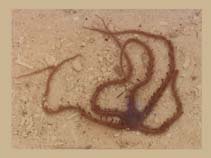Ophiomastix annulosa (Lamarck, 1816)
Chain-link brittle star| Native range | All suitable habitat | Point map | Year 2050 |

|
| This map was computer-generated and has not yet been reviewed. |
| Ophiomastix annulosa AquaMaps Data sources: GBIF OBIS |
Classification / Names Common names | Synonyms | CoL | ITIS | WoRMS
| Ophiacanthida | Ophiocomidae
Environment: milieu / climate zone / depth range / distribution range Ökologie
Riff-verbunden; tiefenbereich 4 - 11 m (Ref. 81187). Tropical
Verbreitung Länder | FAO Gebiete | Ecosystems | Vorkommen | Einführungen
Indo-West Pacific: from Maldives to China.
Length at first maturity / Size / Gewicht / Alter
Maturity: Lm ? range ? - ? cm Max length : 2.4 cm WD Männchen/unbestimmt; (Ref. 87041)
Depth information reported for China (Ref. 81187). Size refers to disk diameter (Ref. 87041). Found beneath coral slabs and in holes and crevices. Possesses enlarged, modified, venomous spines (Ref. 800). Subtidal. Association with Ophiomastix scolopendrina may serve as its strategy in obtaining food from the host's arms (Ref. 102356).
Life cycle and mating behavior Geschlechtsreife | Fortpflanzung | Ablaichen | Eier | Fecundity | Larven
Members of the class Ophiuroidea are mostly gonochoric, others are protandric. Fertilization is external. Brooding is common, bursae is used as brood chambers where the embryos develop into juveniles and later crawl out from the bursal slits. Life cycle: Embryos hatch into free-swimming planktotrophic larvae and later metamorphose into tiny brittle stars which sink down the bottom where they grow into adult form.
Hauptreferenz
Referenzen | Koordinator | Partner
Schoppe, S. 2000. (Ref. 800)
IUCN Rote Liste Status (Ref. 130435)
CITES Status (Ref. 108899)
Not Evaluated
CMS (Ref. 116361)
Not Evaluated
Bedrohung für Menschen
Harmless
Nutzung durch Menschen
| FishSource |
Tools
Mehr Information
Alter/Größe
Wachstum
Länge-Gewicht
Länge-Länge
Morphologie
Larven
Dichte
Wachstum
Länge-Gewicht
Länge-Länge
Morphologie
Larven
Dichte
Internet Quellen
BHL | BOLD Systems | CISTI | DiscoverLife | FAO(Publication : search) | Fishipedia | GenBank (Genom, nucleotide) | GloBI | Gomexsi | Google Books | Google Scholar | Google | PubMed | Tree of Life | Wikipedia (Gehe zu, Suchen) | Zoological Record
Estimates based on models
Preferred temperature
(Ref. 115969): 24.9 - 29.3, mean 28.4 (based on 2609 cells).
Preiskategorie
(Ref. 80766):
Unknown.



